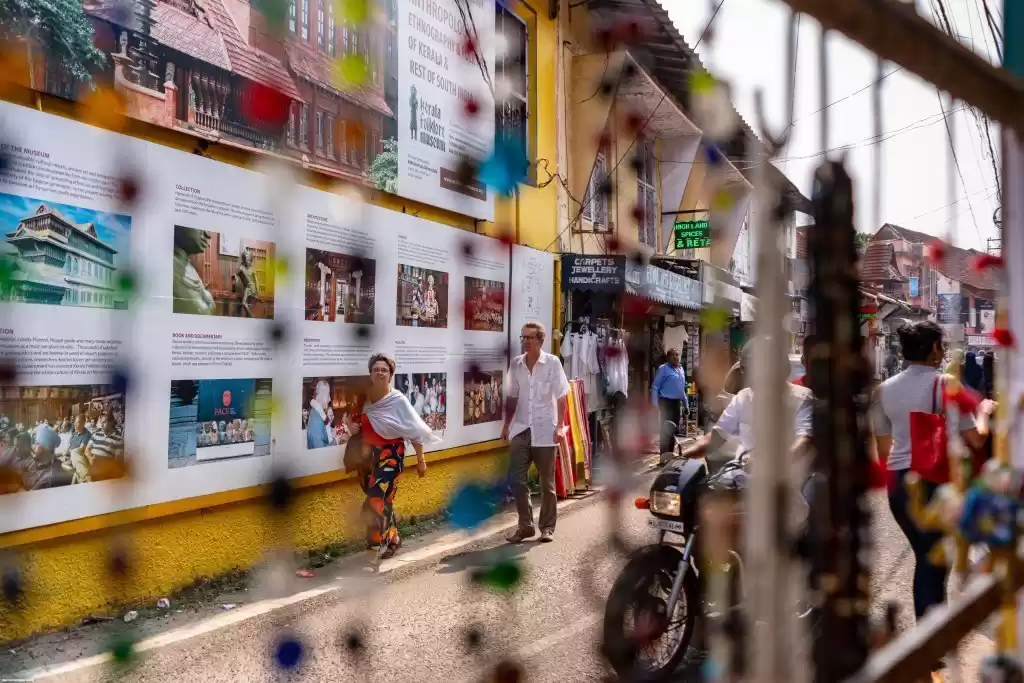
As you tread down from the Western Ghats towards the Arabian Sea, with 600 kilometers of Malabar coastlines – Kerala will greet you in her calm morass of vegetation. Escape into the Deep South to cherish the languid drifts in the backwaters, with an ancient touch of Ayurvedic rub – all in the blissful stroll of aroma, carried by the spices and tea from its northern hills. Bid adieu to the cacophony of everyday India, to indulge in the Malabar delicacies, amid its beauty of traditions, woods and wild cruise through the palm-fringed backwaters on board a private Kettuvallam, a traditional thatched houseboat typical to Kerala, plying these waterways for centuries, connecting villages along the backwaters and transporting rice, spices and other goods, making the cruise, the best option to experience Kerala’s amazing beauty and have glimpse of rural life of the land down south, along the backwaters.
Itinerary: 1N-2D Sumptuous Kerala
Day 1:
On your arrival at Cochin, proceed to Alappuzha, which is still romantically called as Alleppey, the hinterland waters of Kerala, the great vegetation of the Backwaters. On arrival at Alleppey, board on the houseboat, for a night cruise, in the tranquil isolation, amidst the vast lush green, sprawled through the black backwaters under the night sky, where the stars hang like fireflies from heaven, with its crystal reflection on the backwaters of Alappuzha. Spend your laid-back time in the graceful and greenery-fringed, disappearing into a watery world of villages, canoes, toddy shops and of course, houseboats. At the break of dawn, wake up, float along and gaze over rice fields of succulent green, curvaceous rice barges and village life along the banks. Experience one of Kerala’s most mesmerizing beauties, trapped reluctantly in nature, in its virgin form. On your private trip to the backwaters of Alleppey, the famous labyrinth of waterways spanning 900-km, feast on a mouthwatering Kerala-style lunch and dinner, to enjoy savory dishes such as sambar, a hearty vegetable stew, with a vegetable and coconut curry. Tickle your sweet tooth with pappad, a South Indian wafer, and payasam, a rice pudding flavored with cardamom, raisins, saffron, cashew nuts, and pistachios. Soak in the beauty of the landscape from your thatched-roof boat and relish the serenity of the river town, a classic experience of a lifetime.
Day 2:
Bid adieu to the floating paradise, as you have your breakfast and set out for the city of Cochin, else known as Ernakulam, to absorb the hues of its both new and old city. However, as there is not much to cherish in the new city, embark upon the ferry ride from the Main Jetty to drift towards Ernakulam, the old city that will greet you with its fabled Mattancherry Palace, otherwise known as the Dutch Palace. Mesmerize your senses amidst the carefully crafted Hindu murals, depicting scenes from the Ramayana, Mahabharata and Puranic legends in intricate detail. Walk through the central hall on the 1st floor, now a portrait gallery of maharajas from 1864, to feel the, once lavished grandeur by the Dutch royalty. This astonishing grand architecture, built by the Portuguese was presented to the Raja of Kochi, Veera Kerala Varma, as a gesture of goodwill. The impressive collection of palanquins (hand-carried carriages), bejeweled outfits and splendidly carved ceilings has been renovated by the Dutch in 1663, which still stands with all its exquisiteness, for you to delight your senses. The lanes, right around the Palace are filled with antique and tourist curio shops, from where raise the lively port area – Jews Town, a centre for spice traders from the yesteryears. As you will tread through the old, dilapidated buildings, filled with the biting aromas of ginger, cardamom, cumin, turmeric and cloves, you will find the small firms huddled together, with shabby structures around. Look out for the nameplates on the buildings. The Jewish names will confirm your coordinate – you are in the Jew Town. A few steps inward will take you the Synagogue, a smack-bang in the middle of Jew Town. Originally built in 1568, it features an ornate gold pulpit and elaborates hand-painted, willow-pattern floor tiles, all under the grandeur of magnificently illuminated by chandeliers and coloured-glass lamps. As you will explore deeper, Cochin will offer you a town within a town, Fort Kochi. A glimpse of FortImmanuel will take you back in time, when this bastion used to belong to the Portuguese and was a symbol of the strategic alliance which existed between the Maharaja of Cochin and the Monarch of Portugal, after whom the fort is named. Stop by the Thakur House, the Hill Bungalow, still depicts the temper of the colonial era. It was home to the managers of the National Bank of India during the British rule. Walking past the Parade Ground, where the Portuguese, the Dutch and the British had once conducted military parades, to reach the St. Francis Church, the oldest European church in India. Further, in the fort there is a bouquet of foundations awaits your visit, like elite houses, grand gates, reckoning corners, historic streets, estrange bungalows, flamboyant squares, social clubs and winding roads, flavours of colonial past, which still hang in its air. Outside this microcosm, have a view of the Chinese fishing nets, also, known as Cheenavala in the vast macrocosm of the coast along Fort Kochi and Vypeen, which are dotted with these nets, introduced by the Chinese traders of the Kublai Khan Court. Outside China, these are found only in Kochi. Stroll along the Fort Kochi Beach, at sunset with the Chinese fishing nets and sailing ships at the backdrop, to hold a soul full of memorable experience, before you go back to your hotel for check out.



























